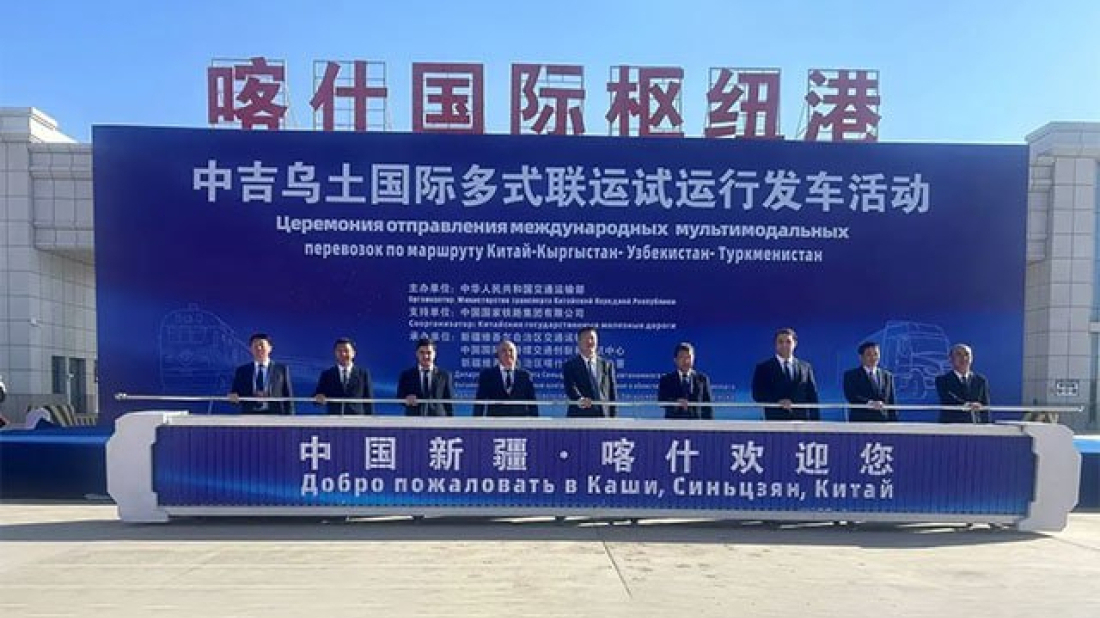Doha Forum: Azerbaijan and Armenia discuss regional peace
At the Doha Forum, Assistant of the President of the Republic of Azerbaijan Hikmat Hajiyev and Secretary of the Armenian Security Council Armen Grigor...

A new multimodal transport corridor linking China, Kyrgyzstan, Uzbekistan and Turkmenistan has officially opened, marking the completion of the long-planned China–Kyrgyzstan–Uzbekistan railway project, which began construction on 27 December 2024.
Valued at approximately $4.7 billion, the 486-kilometre line seeks to transform freight flows across Central Asia, offering faster, more efficient connections between East and West.
Railway project: Decades in the making
The railway backbone was negotiated for over 25 years before construction works formally started. On 27 December 2024, the governments of Kyrgyzstan, Uzbekistan and China signed investment agreements following years of feasibility studies and route consultations. President of Kyrgyzstan Sadyr Japarov described the project as a “strategic bridge between East and West,” emphasising its potential to unlock opportunities in trade, tourism and industry.
Route, technical features and scale
Beginning in Kashgar (China), the line crosses Torugart, Makmal and Jalal-Abad (Kyrgyzstan), before terminating in Andijan (Uzbekistan). Of the total distance, approximately 312 km crosses the Kyrgyz territory. Given the rugged, high-altitude terrain, project engineers built 81 bridges and 41 tunnels, spanning over 120 km in total tunnel length. The railway uses two different gauges: 1,435 mm from the Chinese border to Makmal, and 1,520 mm onward, enabling integration with Chinese rail standards as well as Central Asian networks.
Financing and stakeholder contributions
The total cost of the railway is estimated at $4.7 billion. China holds a 51% stake in the joint venture, while Kyrgyzstan and Uzbekistan each hold 24.5%. China contributes around $1.18 billion, Kyrgyzstan about $700 million, and Uzbekistan and Kyrgyzstan also committed $573 million each through their national budgets. A non-commercial Chinese loan of approximately $2.35 billion supports the financing, with negotiations underway with China Eximbank and the National Bank of China. In mid-2025, Uzbekistan allocated $255 million to the project company’s charter capital.
Corridor launch and operational dynamics
The first freight movement — lighting equipment, machinery and consumer goods — departed from Kashgar in seven vehicles. The route combines rail, road and sea: goods move by rail from China into Central Asia, traverse Uzbekistan, then proceed to Turkmenistan via Turkmenbashi Port, with onward maritime shipping across the Caspian Sea toward Türkiye and Europe.
Impact, capacity and future prospects
By 2035, the railway is expected to carry up to 5 million tonnes of cargo annually, more than half of it transit freight. Stakeholders anticipate the corridor will reduce logistics costs, cut transit times, and provide Central Asia with alternatives to older northern transit routes through Russia and Kazakhstan. Observers also view the project as dovetailing with the Belt and Road Initiative, strengthening the region’s capacity for trade, cross-border cooperation and infrastructure investment.
The 2026 FIFA World Cup draw at the Kennedy Center in Washington, D.C., has finalized the group stage for the tournament co-hosted by the U.S., Canada, and Mexico, setting the schedule and matchups for next summer’s expanded 48-team event.
FIFA releases the 2026 World Cup schedule with match dates, venues, and key fixtures. See when host nations USA, Mexico, and Canada play and get an overview of group stage and knockout rounds.
A group of soldiers has appeared on Benin’s state TV announcing the dissolution of the government in an apparent coup, the latest of many in West Africa.
Pakistan and Afghanistan exchanged heavy fire along their shared border late on Friday, a reminder of how sensitive the frontier remains despite ongoing diplomatic efforts.
Iran’s Foreign Ministry has strongly condemned the Gulf Cooperation Council (GCC) for its support of the claims by United Arab Emirates on three Iranian islands.
At the Doha Forum, Assistant of the President of the Republic of Azerbaijan Hikmat Hajiyev and Secretary of the Armenian Security Council Armen Grigoryan discussed the peace process between the two countries.
Kremenchuk, an industrial centre on the Dnipro River, was struck again as Russian forces targeted facilities across the city during the night.
A giant Christmas tree adorned with red and gold baubles stands in the West Bank city of Bethlehem for the first time since 2022.
On 5 December 2025, residents of Hama filled the streets, balconies, rooftops, main squares, waving flags and chanting slogans, celebrating the first anniversary of the departure of forces loyal to Bashar al-Assad.
You can download the AnewZ application from Play Store and the App Store.

What is your opinion on this topic?
Leave the first comment